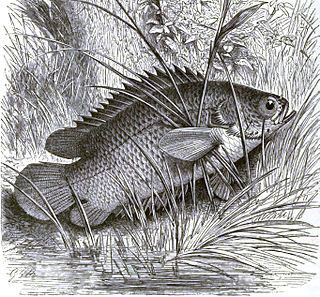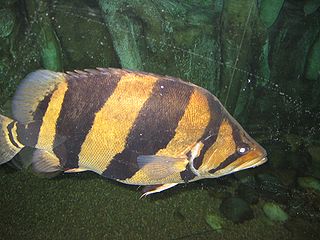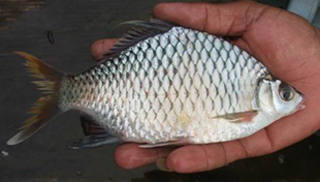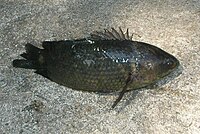
The Anabantidae are a family of ray-finned fish within the order Anabantiformes commonly called the climbing gouramies or climbing perches. The family includes about 34 species. As labyrinth fishes, they possess a labyrinth organ, a structure in the fish's head which allows it to breathe atmospheric oxygen. Fish of this family are commonly seen gulping at air at the surface of the water. The air is held in a structure called the suprabranchial chamber, where oxygen diffuses into the bloodstream via the respiratory epithelium covering the labyrinth organ. This therefore allows the fish to move small distances across land.

The barramundi, Asian sea bass, or giant sea perch is a species of catadromous fish in the family Latidae of the order Perciformes. The species is widely distributed in the Indo-West Pacific, spanning the waters of the Middle East, South Asia, Southeast Asia, East Asia, and Oceania.

The walking catfish is a species of freshwater airbreathing catfish native to Southeast Asia. It is named for its ability to "walk" and wiggle across dry land, to find food or suitable environments. While it does not truly walk as most bipeds or quadrupeds do, it can use its pectoral fins to keep it upright as it makes a wiggling motion with snakelike movements to traverse land. This fish normally lives in slow-moving and often stagnant waters in ponds, swamps, streams, and rivers, as well as in flooded rice paddies, or temporary pools that may dry up. When this happens, its "walking" skill allows the fish to move to other aquatic environments. Considerable taxonomic confusion surrounds this species and it has frequently been confused with other close relatives. One main distinction between the walking catfish and the native North American ictalurid catfish with which it sometimes is confused, is that the walking catfish lacks an adipose fin. It can survive 18 hours out of water.

The Mekong giant catfish, is a large, threatened species of catfish in the shark catfish family (Pangasiidae), native to the Mekong basin in Southeast Asia and adjacent China. It is considered critically endangered due to overfishing and habitat loss.

The fauna of New Guinea comprises a large number of species of mammals, reptiles, birds, fish, invertebrates and amphibians.

The snakeskin gourami is a species of gourami native to Southeast Asia. Prior to the merging of Belontidae to the family Osphronemidae, the snakeskin gourami was regarded as the largest member of its family. It is still the largest species in its genus and subfamily.

The toli shad or Chinese herring is a fish of the family Clupeidae, a species of shad distributed in the western Indian Ocean and the Bay of Bengal to the Java Sea and the South China Sea. It may be found in Mauritius and the Cambodian Mekong near the Vietnam border. It inhabits fast-flowing, turbid estuaries and adjacent coastal waters.

The broadhead catfish is an economically important air-breathing catfish that is a native of Southeast Asia. The fish is farmed in ponds for use in human consumption in countries such as Thailand and the Philippines. However, native populations now face extinction due to man-made activities and genetic introgression due to interbreeding with escaped aquaculture hybrids.

The Siamese tigerfish, also known as the Siamese tiger perch, is a species of ray-finned fish belonging to the family Lobotidae, the tripletails and tiger perches. This fish is endemic to Indochina and is assessed as Critically Endangered by the IUCN.

Anabas is a genus of climbing gouramies native to southern and eastern Asia. In the wild, Anabas species grow up to 30 cm (1 ft) long. They inhabit both brackish and fresh water. Anabas species possess a labyrinth organ, a structure in the fish's head which allows it to breathe atmospheric oxygen, so it can be out of water for an extended period of time, hence its name from the Greek anabainein ‘walk up’, from ana- ‘up’ + bainein ‘go’. They are carnivorous, living on a diet of water invertebrates and their larvae, and - in contrast to most of their relatives - are scatter spawners with no parental care. Species are found in South Asia, including India, Sri Lanka, Bangladesh, Burma, Indonesia, Malaysia, Thailand, Cambodia, and the Philippines.

The bronze featherback is a ray-finned fish in the family Notopteridae found in South and Southeast Asia. Although primarily found in fresh water, it has been known to enter brackish water. At present, it is the only member of the genus Notopterus, but as currently defined, it is likely a species complex.

Hypsibarbus wetmorei, the golden belly barb, lemon fin barb,lemon barb or Kerai is a species of cyprinid fish. It is native to the Mae Klong, Mekong, Chao Phraya, Tapi and Pahang rivers in Mainland Southeast Asia. Although locally common and considered to be a species of Least Concern, it is threatened by overfishing, dams and pollution. It typically reaches 25 cm (10 in) in length, but has been recorded up to about 70 cm.

The smallscale archerfish is a perciform fish of genus Toxotes. As its name suggests, the scales of the smallscale archerfish are smaller than those of other archerfish. They reach a maximum length of 15 centimetres (5.9 in). Smallscale archerfish live in the tropical Indo-Pacific region and are potamodromous, moving between fresh and brackish water through their lifetimes.

The marble goby is a widely distributed species of fish in the family Butidae native to fresh and brackish waters of the Mekong and Chao Praya basins, as well as rivers and other water bodies in Cambodia, Thailand, Malaysia, Singapore, Indochina, the Philippines, and Indonesia. It is among the largest gobioid fish, reaching a length of 65 cm (26 in), though most do not exceed 30 cm (12 in).

The short mackerel or shortbodied mackerel is a species of mackerel in the family Scombridae. Its habitat is the shallow waters of Southeast Asia and Melanesia, feeding mainly on small zooplankton. It is of major importance to the fisheries industry.

Datnioides is a genus of ray-finned fish belonging to the family Lobotidae. These fishes are commonly known as tigerfish, tiger perch or freshwater tripletails. These fishes are found in the rivers of southern Asia and new Guinea.

Macrochirichthys macrochirus, the long pectoral-fin minnow and giant sword minnow or freshwater wolf-herring, is a species of cyprinid fish found in rivers and lakes in Southeast Asia where it is used as a food fish. It is the only member of its genus. It is predatory and reaches up to 1 m (3.3 ft) in length.

Scaphognathops is a genus of cyprinid fishes found in Southeast Asia. Thai vernacular names are pla pak pian, pla pian (ปลาเปี่ยน) or pla ta dam (ปลาตาดำ). It is restricted to Mekong Basin, and not easy to find.

Datnioides undecimradiatus, the Mekong tiger perch is a species of freshwater fish belonging to the family Lobotidae, the triplefins and tiger perches. This species is endemic to the lower and middle Mekong basin in Indochina.

Datnioides polota, the silver tigerfish, silver tiger perch, barred tigerfish, fourbanded tripletail, fourbanded tigerfish or fourbarred tigerfish, is a species of ray-finned fish belonging to the family Lobotidae, the tripletails and tiger perches. This fish is found in southern Asia and New Guinea.
























